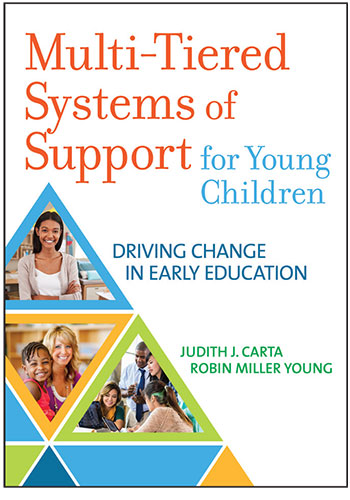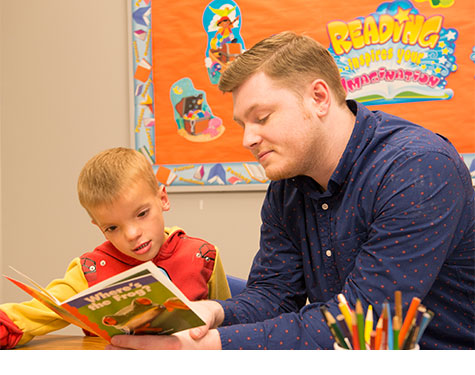 Robin Miller Young, assistant professor in the Department of Special and Early Education, is celebrating recent publication of “Multi-Tiered Systems of Support for Young Children: Driving Change in Early Education.”
Robin Miller Young, assistant professor in the Department of Special and Early Education, is celebrating recent publication of “Multi-Tiered Systems of Support for Young Children: Driving Change in Early Education.”
Co-edited by Judith J. Carta, the book presents the wisdom and research findings of more than 25 experts on Multi-tiered Systems of Support (MTSS). Young also co-authored three of the 13 chapters.
MTSS is a system-wide, prevention-oriented framework for schools and other agencies to provide effective educational services and supports, matched to children’s needs, so they can gain essential skills, knowledge and dispositions.
Key to its success is a data-based decision-making process that ensures learners receive appropriately intensive instruction, arranged in a tiered model, which results in learners mastering essential skills.
“The Multi-tiered Systems of Support initiative is being promoted by early childhood educators who see the potential of this initiative to achieve outcomes for families and young children that have been elusive until now,” Young says.
Young recently answered questions from the College of Education’s Ed News.
How did you become interested in researching and writing this book?
I completed my doctorate at NIU, and was fortunate to conduct my dissertation research with Drs. Bill Bursuck and Shirley Dickson, examining practices to teach early reading skills in a two-tiered instructional model. Specifically, kindergarten children were taught the standard language and early literacy curriculum by their regular classroom teachers. Next, we identified children who were at risk of developing delayed reading skills and I taught the children phonological awareness (PA) skills in small groups in their standard classrooms for two months (a Tier 2 or Strategic Intervention). Almost all of the students who participated in the PA instruction caught up to their peers and were no longer at risk! Based on our findings, I developed a lifelong pursuit to know more about raising students’ achievement of essential outcomes by providing them with evidence-based instruction of varying intensities matched to their needs.
How is MTS for young children different from MTSS for older children?
MTSS frameworks for young children are highly similar, though not identical, to the models developed for older children. Specifically, both are supported by federal legislation such as the Every Student Succeeds Act and the Individuals with Disabilities Education Act. However, the models for older children are provided almost exclusively in K-12 public schools, whereas in MTSS for young children, the instruction and interventions are delivered in a wide variety of early learning programs designed for those from birth to third-grade. Our book addresses primarily programming for those between the ages of 3 to kindergarten eligibility. A formal position statement describing MTSS practices for young children has been endorsed by the three largest national early education professional associations (e.g., NAEYC, DEC and Head Start), which provides further support for the MTSS framework.

What are the defining features of the MTSS framework for young children?
MTSS is founded on the use of evidence-based instruction and intervention practices (EBPs), those that have been shown through high-quality research to be effective in improving young children’s outcomes when implemented with fidelity. Throughout our book and videos, we identify EBPs and processes to ensure that the practices are implemented as designed (e.g., with fidelity), and we provide multiple illustrations in print and in video of how they can be used at the program-, classroom- and individual-child levels. Universal screening and progress monitoring should occur at multiple times of the year to reflect the effectiveness and efficiency of the core curriculum. If children are not meeting benchmarks, then the Instructional Leadership Team can look more closely at the core curriculum and its implementation to determine how to improve children’s skill proficiencies, thereby allowing them to meet the performance benchmarks. Progress monitoring ensures that we identify children who may need additional instructional supports to gain early academic skills or address challenging behavior, and then we monitor their progress in the intervention to ensure success.
Why does MTSS recommend a layered continuum of supports?
Programs need tiers of instructional supports that can become more intensive or less intensive, depending on the students’ needs. Most frameworks use three or four tiers, with Tier 1 serving as the core curriculum. A child can enter an early learning setting with the level of instructional intensity that is matched to their needs; then, a strengths-focused, data-based problem solving and decision making process, that uses a collaborative team approach with parents and staff, is employed to monitor progress and vary the instructional intensity to continue meeting the students’ needs.
The subtitle of your book is “Driving Change in Early Education.” How can MTSS “drive” the changes that need to be made?
Most efforts to improve early education have been reactions to policies and events that have taken place in the field. They targeted smaller, more finite parts of the way services are designed and delivered; they focused on benefitting only a subgroup of children; they were promoted or advanced by a small group of stakeholders; and there was not a coherent plan to introduce the initiative and then to implement it to the point of sustainability. In contrast, the MTSS innovation is prevention oriented: It shifts the way system infrastructures are aligned and operated to achieve measurable results, and it is designed for all young children and their families. We also promote use of Implementation Science to create a coherent plan to ensure that the innovation practices are sustained into the future.
 What goals can be accomplished with MTSS for young children?
What goals can be accomplished with MTSS for young children?
We have known for more than 20 years that “the size of a child’s vocabulary at age 3 and the trajectory of vocabulary learning are strong predictors of literacy and later school success” (Hart & Risley 1995). All young children will be actively engaged in vocabulary building activities that match their current performance levels and help them achieve ambitious goals, giving them the best possible chances for kindergarten readiness and beyond. Educators and parents need to help children “Bridge the 30 Million Word Gap” that exists between the children who have robust vocabularies and have strong conceptual knowledge of word networks and those who have limited word knowledge and conceptual networks. Additionally, early learning programs are shifting into MTSS frameworks designed to teach all young children prosocial skills, such as following directions, sharing materials, appropriately expressing one’s feelings and problem-solving equitable solutions to conflicts to reduce the number of young children who demonstrate challenging behaviors that results in their expulsion and suspension from early learning programs (CEELO 2015).
Why is this book and video series critical for early childhood educators?
Creating an Instructional Leadership Team makes sure that all resources are directed toward answering the following questions, which define the work of Professional Learning Communities (PLCs): What do we want our children and families to learn? How will we know when they have learned it? How will we respond when some children don’t learn? How will we extend and enrich the learning for students who are already proficient? When early education leaders, such as principals and program directors, value the use of school/program Instructional Leadership Teams to identify program strengths and to engage in a continuous data-based improvement process, this shared leadership and team-based problem-solving process gives teachers and other team members ownership of the instructional variables that can lead to achievement of essential learning targets.
Who else will need to know about this work?
Resource specialists, such as school psychologists, speech/language pathologists and professionals who support young Dual Language Learners who are learning English and their native language. Without an MTSS system in place, the educational programming would be essentially a “one size fits all” approach, which would not benefit very many young children nor represent good stewardship of our precious human and financial resources. An MTSS system that includes a strong core curriculum, customized services and supports and data-based decision-making has the greatest likelihood of ensuring that all children achieve ambitious goals, become fluent readers and participate successfully in many kinds of school, family and community settings.

